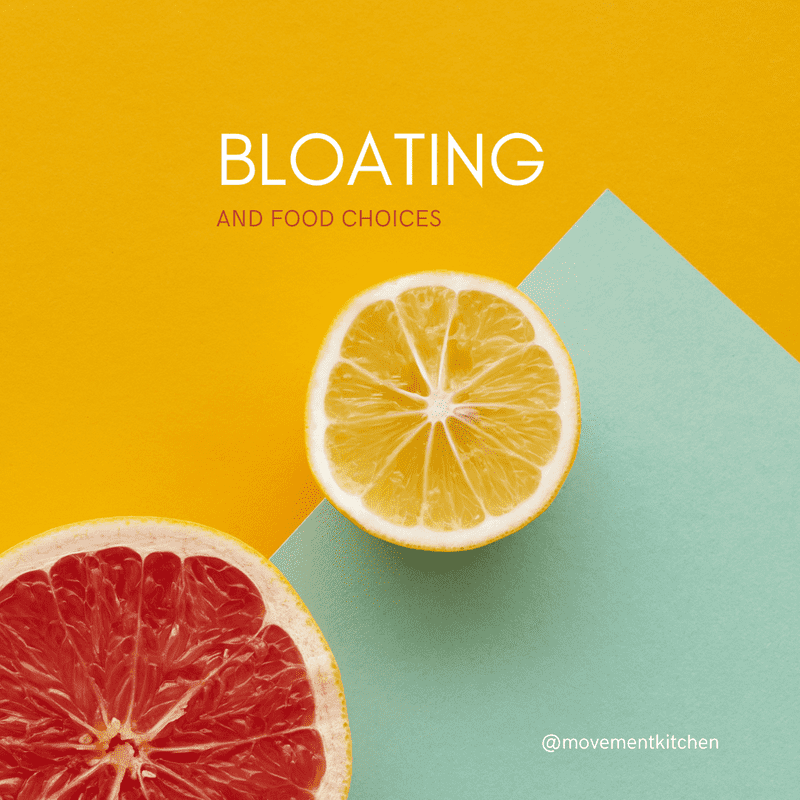Foods That Make Our Bellies Rounder
08 September 2023
Welcome to the Bloating Series

Do you ever experience this uncomfortable feeling of belly tightness, pressure and increased abdominal size? I definitely do, especially towards the end of my cycle and when I end up eating later in the evenings. Sometimes my children make fun of me or I get self-conscious and choose looser tops to hide my belly.
I went out with a friend the other night and she complained about the same thing. So, I thought: why wouldn’t I research and write about abdominal bloating, especially its mechanical factors, e.g. how it affects breathing and torso mechanics?
So I dug myself up into medical journals and recorded some videos with solutions that I’ve been using personally and with my clients. But it turned out there was way too much material for one post, so I ended up creating a series exploring different aspects of bloating as a multi-factorial and so much more than an aesthetic problem.
Let’s start with food and bloating.
If you think certain foods could be a cause of your bloating, it might be a good idea to write a food diary for a couple of days/weeks and see what makes your symptoms worse.
Do you use artificial sweeteners? In the last decade or so, researchers identified a group of poorly absorbed sugars (FODMAPs) that get fermented in the gut producing methane and carbon dioxide and wracking havoc with digestion in general. The notorious FODMAPs include fructose, lactose and artificial sweeteners (such as sorbitol, mannitol, xylitol, and glycerol). There is evidence that removing these from your diet could decrease symptoms of bloating (see Lacy, 2020). Look up the Low FODMAP diet for ideas.
Another controversial food are cruciferous vegetables (kale, broccoli, cauliflower, cabbage, Brussels sprouts and other vegetables with flowers whose four petals resemble a cross). One one hand, they contain raffinose, a gas-producing sugar that could make you bloated. On the other hand, they are crucial for oestrogen metabolism and healthy hormonal balance in mid-life women (see Fowke, 2000). Also, they contain glucosinolate which are found to have a strong protective effect against cancer (see Esteve, 2020) – definitely not a good idea to chuck them out completely! You could try steaming or cooking your broccollis and cauliflowers, to make them easier to digest.
Beans, lentils and peas could also cause excessive gas. They do contain plenty of protein, but also sugars that and fibers that our bodies can’t fully break down. This is why it makes sense to soak them the night before, or at least quick-soak them in warm water before cooking. Another trick is to combine legumes with easily digestible grains like rice or quinoa. We want the body to get used to fiber-rich foods that in a long-run keep the gut healthy.
Dairy could be a problem for some people. If you are lactose-intolerant, you miss the enzymes needed to digest lactose (the milk sugar) and poorly digested sugar means extra gas and bloating. But before you cut out dairy completely, you might want to try a lactase enzyme supplement to see if it helps you digest dairy.
There is evidence that probiotic supplements can help reduce gas and bloating, especially bifidobacteria strains, which don’t create gas with fermentation (Check Foley, 2014).
You can try incorporating probiotic-rich foods into your diet, such as yogurt, kefir, sauerkraut, kimchi contain strains of bacteria that support a healthy gut. If you find lactose difficult to digest, go for the lactose-free or no-dairy probiotics.
Again, everyone is different, listen to your body and observe which foods work or don’t work for you. But as a rule of thumb, a balanced diet, plenty of water and moderate portion sizes could be a good start.
Stay tuned for the next post on bloating, exploring how hormones influence digestion in women.
Dig more about this:
- Esteve M. (2020). Mechanisms Underlying Biological Effects of Cruciferous Glucosinolate-Derived Isothiocyanates/Indoles: A Focus on Metabolic Syndrome. Frontiers in nutrition, 7, 111. https://doi.org/10.3389/fnut.2020.00111
- Foley, A., Burgell, R., Barrett, J. S., & Gibson, P. R. (2014). Management Strategies for Abdominal Bloating and Distension. Gastroenterology & hepatology, 10(9), 561–571.
- Fowke, J. H., Longcope, C., & Hebert, J. R. (2000). Brassica vegetable consumption shifts estrogen metabolism in healthy postmenopausal women. Cancer epidemiology, biomarkers & prevention : a publication of the American Association for Cancer Research, cosponsored by the American Society of Preventive Oncology, 9(8), 773–779.
- Lacy, B.E., Cangemi, D. and Vazquez-Roque, M. (2020). Management of Chronic Abdominal Distension and Bloating. Clinical Gastroenterology and Hepatology, 19(2). doi:https://doi.org/10.1016/j.cgh.2020.03.056.
- Njoumi S, Josephe Amiot M, Rochette I, Bellagha S, Mouquet-Rivier C. Soaking and cooking modify the alpha-galacto-oligosaccharide and dietary fibre content in five Mediterranean legumes. International Journal of Food Sciences and Nutrition. 2019;70(5):551-561. doi:10.1080/09637486.2018.1544229